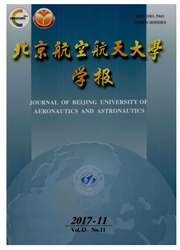

 中文摘要:
中文摘要:
随着智能交通技术的发展,可变信息标志(VMS,Variable Message Signs)被广泛应用于动态交通管理中.元胞传输模型(CTM,Cell Transmission Model)可以很好地模拟交通流激波、排队形成与消散等交通流动力学特性.提出一种新的基于CTM的路径行驶时间计算方法,并使用LOGIT原则计算路径选择概率,针对重复性拥挤和非重复性拥挤2种交通状况,分析了VMS对交通流的影响.数值模拟结果表明,理论模型能够合理反映现实的交通状况:发生重复性拥挤时,VMS能够合理疏导人们的出行,减缓交通拥挤;而发生非重复性拥挤时,VMS对高需求和低需求情形下的交通流影响相似,但在高需求情形下,路径选择对模型参数的敏感区很小.
 英文摘要:
英文摘要:
The variable message signs (VMS) have been widely used in guiding and managing the dynamic traffic with development of intelligent transportation technologies. Such traffic dynamics as shock waves and jam can be well reproduced by cell transmission model ( CTM). A new method to estimate the route travel times based on the CTM was presented and the LOGIT rule to govern the route choice was adopted. The impacts of VMS on recurrent and non-recurrent congestion were numerically investigated using the formulae proposed. The real-life traffic conditions could well be reproduced as simulation results shown. Travelers' decision making could be positively influenced by the VMS so as to alleviate the grave degree of recurrent congestion. In the case of non-recurrent congestion, the VMS induced similar effects no matter high and low the traffic demand was. However, the resultant flow pattern was sensitive within a small range of the model parameter when the demand was high.
 同期刊论文项目
同期刊论文项目
 同项目期刊论文
同项目期刊论文
 Equity and efficiency analysis of pricing strategies in a bi-modal network with heterogeneous user g
Equity and efficiency analysis of pricing strategies in a bi-modal network with heterogeneous user g Modeling the evolutions of day-to-day route choice and year-to-year ATIS adoption with stochastic us
Modeling the evolutions of day-to-day route choice and year-to-year ATIS adoption with stochastic us Modeling time-dependent travel choice problems in road networks with multiple user classes and multi
Modeling time-dependent travel choice problems in road networks with multiple user classes and multi One-step solution fabrication of magnetic chains consisting of jingle-bell-shaped cobalt mesospheres
One-step solution fabrication of magnetic chains consisting of jingle-bell-shaped cobalt mesospheres Support vector machine forecasting method improved by chaotic particle swarm optimization and its ap
Support vector machine forecasting method improved by chaotic particle swarm optimization and its ap Static floor field and exit choice for pedestrian evacuation in rooms with internal obstacles and mu
Static floor field and exit choice for pedestrian evacuation in rooms with internal obstacles and mu A model for evaluation of transport policies in multimodal n etworks with r oad and p arking capacit
A model for evaluation of transport policies in multimodal n etworks with r oad and p arking capacit Optimization of time-varying parking charges and parking supply in networks with multiple user class
Optimization of time-varying parking charges and parking supply in networks with multiple user class The characteristic analysis of the traffic flow of trains in speed-limited section for fixed-block s
The characteristic analysis of the traffic flow of trains in speed-limited section for fixed-block s How non-uniform tolerance parameter strategy changes the response of scale-free networks to failures
How non-uniform tolerance parameter strategy changes the response of scale-free networks to failures Cellular automaton model with time gap dependent randomization under Kerner's three-phase traffic th
Cellular automaton model with time gap dependent randomization under Kerner's three-phase traffic th 期刊信息
期刊信息
